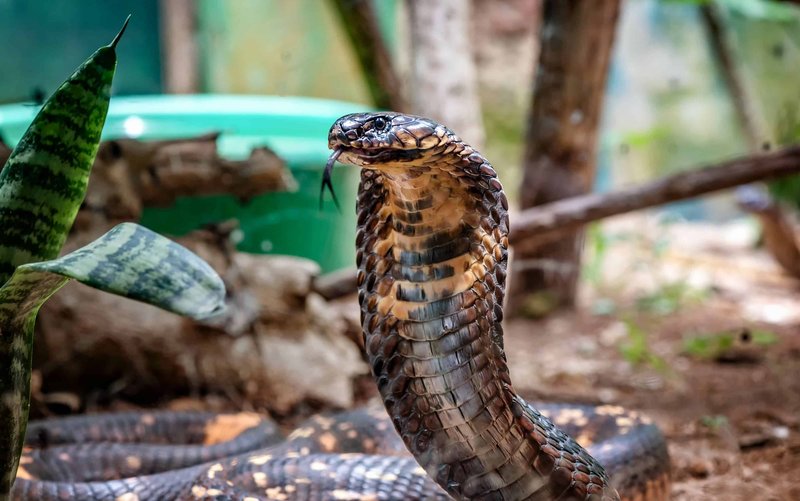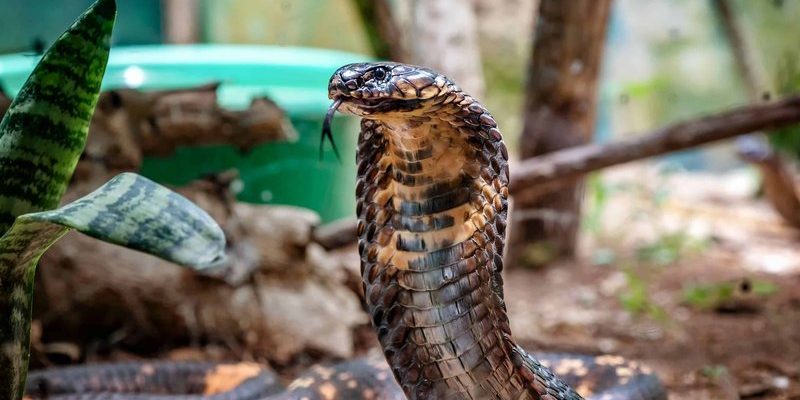
In this article, we’ll dive into some of the most common myths surrounding the king cobra. We’ll break down the facts and separate truth from fiction. So grab your coffee, sit back, and let’s talk about why the king cobra deserves a spot on your list of nature’s wonders instead of just a scary nightmare!
Myth 1: King Cobras are Aggressive and Will Chase You
Many people believe that king cobras are constantly on the hunt for humans, ready to strike at any moment. Here’s the thing: while they are certainly capable of delivering a potentially lethal bite, king cobras are not typically aggressive. In fact, they are quite shy and prefer to avoid confrontation.
When a king cobra feels threatened, it will usually display its hood and hiss as a warning before retreating. They’d rather slither away than engage in battle. If you come across one in the wild, chances are it’s more interested in escaping than chasing after you.
In the rare instances where a king cobra does feel cornered, it can indeed strike. However, most snake encounters can be avoided by simply giving them space. So, unless you’re trying to corner one, you can rest easy knowing that you probably won’t become a cobra’s next target.
Myth 2: All Cobras Are Venomous, but King Cobras Are the Most Dangerous
It’s true that all cobras possess venom, but not all of them are created equal. The king cobra has a reputation for being one of the most venomous snakes in the world, but that doesn’t mean it’s the most dangerous to humans.
While its venom is powerful and can affect the nervous system, the actual number of people harmed by king cobras is relatively low. Other snakes, like the black mamba or various vipers, are responsible for more human fatalities. Here’s the kicker: the king cobra’s venom is primarily designed for hunting its preferred prey—other snakes!
So, while it’s wise to respect this snake, being cautious doesn’t mean you should live in fear. Understanding the facts can help you appreciate the king cobra for the incredible creature it is, rather than just a villain in a scary story.
Myth 3: King Cobras Only Live in Deserts
When you think of cobras, you might picture sun-baked deserts or arid landscapes. In reality, king cobras predominantly inhabit forests, jungles, and tropical regions across Southeast Asia and India. They thrive in environments where they can easily find shelter and hunt for food.
These snakes are surprisingly adaptable. They can be found near water, making them great swimmers. A king cobra might be coiled around a tree branch or resting near a stream, basking in the sun’s warmth. So, if you’re planning a trip to an exotic location, don’t just stick to deserts—keep an eye out for them in lush, forested areas, too!
Myth 4: King Cobras are Solitary Creatures
You might imagine king cobras living a lonely life, hiding out in their dens and avoiding all social interaction. While it’s true that they are primarily solitary, king cobras actually engage in some interesting social behaviors, especially during mating season.
During this time, male king cobras may engage in combat with each other to win over females. They’ll wrestle in a dramatic display, rising high off the ground and entwining around each other. It’s quite a sight to behold! After mating, the female will lay her eggs and even guard them fiercely, proving that they aren’t as solitary as you might think.
So, while king cobras prefer to go about their lives alone most of the time, they can be quite sociable when it comes to love and family.
Myth 5: King Cobras are Immune to Their Own Venom
It’s a common misconception that king cobras can bite themselves without any harm. Truthfully, they are not immune to their own venom. In fact, if a king cobra were to bite itself, it could face serious health consequences—even death.
Like many snakes, king cobras rely on their venom to subdue prey, but it’s crucial for their survival to avoid self-inflicted bites. In the wild, they generally exercise extreme caution when feeding and attacking to prevent accidents.
This myth perhaps stems from the snake’s impressive ability to tolerate high doses of venom from other snakes, but that doesn’t translate to immunity. They may be apex predators, but they are still vulnerable.
Myth 6: King Cobras are Breathing Fire
You might have heard tales about king cobras breathing fire, much like dragons in stories. Let me explain: this is purely fictional. King cobras can’t breathe fire, although their defensive displays can be intimidating enough to feel like they might!
When threatened, a king cobra will flare its hood, hiss loudly, and may even strike if it feels cornered. The visual display aims to scare off predators and isn’t unlike a peacock showing its feathers. These actions serve as a warning, but rest assured, no flames will follow!
While it’s all fun and games to imagine fiery serpents, the reality is far more fascinating. The next time you hear about a king cobra, remember that they wield their power with cunning and grace—not with fire!
Myth 7: King Cobras are Dangerous to All Animals
While king cobras are certainly powerful predators, they are selective about their prey. They primarily feed on other snakes, including venomous varieties like pit vipers and even smaller cobras. You might wonder how they handle such dangerous meals; their incredible reflexes and feeding strategy help them manage it safely.
Interestingly, king cobras are not typically aggressive toward larger animals or humans unless they feel threatened. They prefer to strike at smaller creatures they can overpower, so while they are formidable hunters, they also know their limits.
This selective hunting behavior challenges the stereotype of the king cobra as a ruthless killer. They may be dangerous to small animals, but they approach larger threats with caution, showcasing their intelligence and adaptability in the wild.
Understanding the King Cobra: A Magnificent Creature
King cobras may evoke fear, but they are so much more than just a terrifying snake. They play an essential role in their ecosystems, helping control snake populations and maintaining balance in their habitats. Remember, understanding these myths and facts about the king cobra not only deepens your appreciation for wildlife but also fosters a respect for these incredible creatures.
So next time you hear a chilling story about the king cobra, take a moment to reflect. This snake, with its impressive length and majestic hood, is not just a monster lurking in the shadows. Instead, it’s a vital part of nature that deserves our understanding and respect. Let’s celebrate the king cobra for what it truly is: a fascinating wonder of the animal kingdom!

